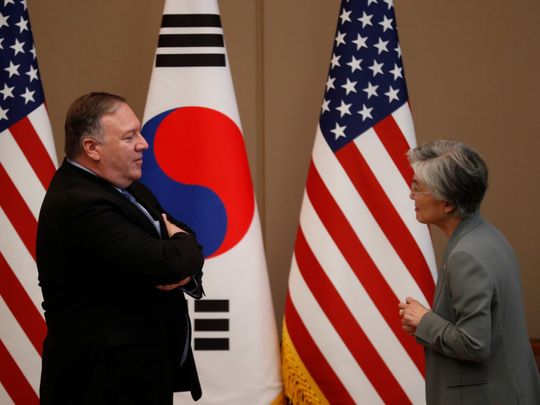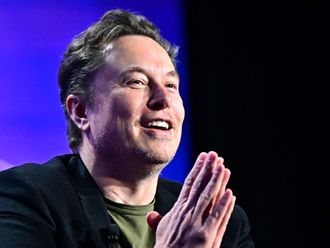
Mike Pompeo capped off the final leg of his latest Asia tour in South Korea on Sunday after previous stop-offs in Japan and India. This latest trip, which saw Donald Trump join him in Japan and Korea, saw the US secretary of state and president doubling down on embedding their revamped US Indo-Pacific strategy in the face of China’s growing strength.
One of the big potential windows of opportunity Pompeo senses, right now, in the Indo-Pacific (the Trump team’s preferred phrase for the massive geography spreading from the US West Coast to India) comes with the landslide re-election of Narendra Modi. Hence the reason why New Delhi, which is also wary of Beijing’s rise to power, was the first pit stop for Pompeo before he headed to Japan — for the G20 summit and a series of key bilateral meetings, including to push forward US trade deals with Tokyo and Beijing — and then to Korea where nuclear negotiations were top of the table.
To be sure, there remain some irritants in the Washington-New Delhi relationship, including US threats to levy sanctions if India continues to buy Russian military equipment. Moreover, the two nations are also in dispute over tariffs, and the possibility of US restrictions on work visas for Indian professionals in retaliation for New Delhi’s insistence on local data storage by big foreign firms.
Nevertheless, Pompeo’s talks in New Delhi in recent days, including with Modi, were largely upbeat. The deepening of the US-India relationship is centred around promoting a regional agenda of ensuring “freedom of the seas and skies, promoting market economics, supporting good governance, and insulating sovereign nations from coercion”, and a key part of the overall US rationale for its revamped US Indo-Pacific strategy is enabling India to potentially act as a counterweight to China.
Pompeo sought in recent days to convince US allies that the Trump team is wholly committed — politically, economically and security-wise — to the region.
To this end, Washington declared New Delhi a major US defence partner in 2016. And last September Pompeo helped finalise with India a Communications Compatibility and Security Agreement, underpinning greater counter-terrorism and defence cooperation, which then-Defence Minister Nirmala Sitharaman claimed elevated bilateral relations “to unprecedented heights”, including the first bilateral military exercises in the Bay of Bengal later this year.
The success of that India trip last Autumn helped bring greater credibility to the US Indo-Pacific strategy which has come under criticism for its perceived (under) ambition vis-a-vis China with its own ambitious ‘Belt and Road’ scheme. Hence why the secretary of state has spent time during his previous visits there articulating revamped plans for a “new era in US economic commitment to peace and prosperity in the Indo-Pacific region”. This includes plans for some $113 million in regional investments focused on technology, energy and infrastructure that, in the secretary of state’s words, represents “just a down payment” on US commitment to the region.
Yet, welcome as the details of the administration’s emerging plan are for many US allies, critics claim that the strategy will have less overall impact than the Obama administration’s Trans-Pacific Partnership (TPP). To be sure, the Trump team has announced alternative plans to pursue bilateral trade deals in the region, but this has so far had only very limited success with no TPP signatories yet finalising any such US agreements.
And the added pressure on the White House here is China’s monumental ambition in comparison as illustrated by the $1 trillion Belt and Road scheme, plus its alternative vision to TPP of a Free Trade Area of Asia Pacific and the Regional Comprehensive Economic Partnership. Inevitably, this has led to concerns about future US influence in the region, with, for instance, former Obama administration US Trade Representative Michael Froman despairing that Washington “is the one going to be left of the sidelines as others [especially Beijing] move forward”.
Partisan criticism aside of the Trump team’s plan, history also points to the apparent under ambition of current US strategy. Since 1945, US administrations of both Republican and Democratic stripes helped create and nurture key global and regional bodies and institutions that exist to this day from the UN, to the IMF and World Bank that have helped embed US influence.
Inspired by this post-war success, both the administrations of George H.W. Bush and especially Bill Clinton sought to respond to the collapse of Soviet Communism by encouraging creation of a range of institutions including Apec [Asia-Pacific Economic Cooperation]. In this context, the Obama team’s TPP was only the latest example of a global institutional-building project that began in the post-Second World War to embed US influence and encourage growth of democracy and open markets.
It is in this context that Pompeo sought in recent days to convince US allies that the Trump team is wholly committed — politically, economically and security-wise — to the region. Here one key message was that, while his plan is, so far at least, dwarfed in size to that of the Chinese Belt and Road initiative, the US model being promoted is more sustainable adhering to international standards of transparency and the rule of law.
The implicit criticism here is that Beijing, by contrast, could leave countries in massive debt under the Belt and Road’s stress on state infrastructure projects. While this US message resonates with some, other key regional players are nonetheless torn by the massive scale of potential financing offered by China, and real questions remain about the ambition of the Trump team’s regional strategy at a moment of significant geopolitical flux.
Andrew Hammond is an Associate at LSE IDEAS at the London School of Economics









